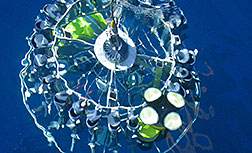- Number 429 |
- December 22, 2014
Salinity matters when it comes to sea level changes

Lined with bottles triggered at different
levels of the ocean, this conductivity,
temperature and depth profiler bearing a
suite of sampling bottles is a mainstay of
oceanography. It can be deployed to depths
of 6,000 meters to study changes in ocean
temperature and salinity.
Photo courtesy of Ann Thresher/CSIRO
Using ocean observations and a large suite of climate models, scientists at DOE's Lawrence Livermore National Laboratory have found that long-term salinity changes have a stronger influence on regional sea level changes than previously thought.
“By using long-term observed estimates of ocean salinity and temperature changes across the globe, and contrasting these with model simulations, we have uncovered the unexpectedly large influence of salinity changes on ocean basin-scale sea level patterns,” said LLNL oceanographer Paul Durack, lead author of a paper appearing a recent issue of the journal Environmental Research Letters.
Sea level changes are one of the most pronounced effects of climate change impacts on the Earth and are primarily driven by warming of the global ocean along with added water from melting land-based glaciers and ice sheets. In addition to these effects, changes in ocean salinity also can affect the height of the sea, by changing its density structure from the surface to the bottom of the ocean.[Anne Stark, 925.422.9799,
stark8@llnl.gov]
